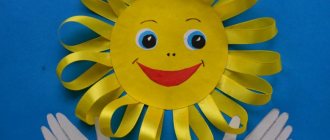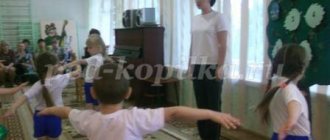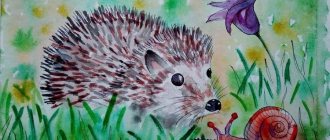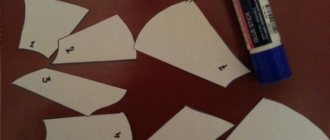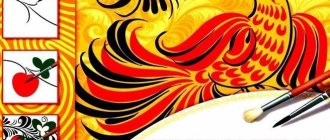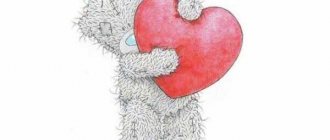Summary of the drawing lesson “Decorate your toys (decorative drawing)”
Lesson notes
“ Decorate your toys
(decorative drawing)”
for children of the general development group, aged 4 to 5 years
Date of:
Educational area:
Artistic and aesthetic development
Class:
Drawing
Priority:
Artistic and aesthetic development is integrated with physical development, social and communicative development, speech development, cognitive development.
Target:
introduce children to the features of Dymkovo painting.
Tasks:
Educational:
— Continue to introduce children to Dymkovo toys, teach them to note their characteristic features, and highlight the elements of the pattern: circles, rings, dots, stripes.
— To strengthen children’s understanding of the bright, elegant, festive colors of toys.
— Reinforce brush painting techniques.
Educational:
— Develop aesthetic perception.
Educational:
— Cultivate accuracy in working with gouache.
Preliminary work:
Acquaintance with Dymkovo products and their painting. Modeling toys.
Forms of work
: Individual, joint activities of the teacher with children, independent activities of children.
Methods:
Verbal:
questions for children, conversation about toys.
Visual
: Dymkovo young ladies, duck, horses, pictures of Dymkovo toys, a sample of a decorated toy
.
Practical:
productive activity.
Types of children's activities
: gaming, communicative, motor, productive.
Individual work
: One toy is drawn on the sheet, draw and paint the second one by analogy.
Materials and equipment:
Demo material
: Dymkovo young ladies, duck, horses, pictures of Dymkovo toys, a sample of a decorated toy
.
Handout:
Landscape sheets, gouache paints, brushes, a jar of water, a napkin (for each child).
Motivation:
invitation to the Dymkovo Toy Museum.
Progress of the lesson:
I. _ Introductory part
Motivational moment:
Educator:
Guys, today I have prepared a surprise for you.
Have you ever been to a museum? ( children's answers
) I invite you to the museum.
Would you like to visit the museum with me? ( children's answers
) Close your eyes (
music sounds
).
Open your eyes. Here we are in the museum ( they go to the table with toys
)
II.
Main part Educator:
Today there is a toy exhibition at the museum.
Look at them, how bright and elegant they are. Can someone tell me what these toys are called? ( children's answers - Dymkovo
) That's right, this is a Dymkovo toy!
Let's, guys, remember the history of this toy. Why were they called that? ( children's answers - because they were made in the village of Dymkovo
) Educator: Why was this village called Dymkovo?
( children's answers
) That's right, because in winter, when the stoves are heated, and in summer, when there is fog, the village seems to be in a haze (
looking at pictures of a village in winter)
Educator:
There is a column of smoke from the chimneys, as if everything is in a haze.
They gave a blue light, and the large village was named “Dymkovo”. People loved songs and dances there, and wonderful fairy tales were born in the village. All toys are not simple, but magically painted. They themselves are snow-white, like birch trees, and they have bright circles, squares, and stripes on them. Educator: Yes, in the old days, in the village of Dymkovo, the Dymkovo toy was born.
What did the craftsmen make it from? ( children's answers - We made this toy from clay)
.
But clay toys don’t look very elegant, so how did Dymkovo ones turn out so cheerful and elegant? ( children's answers - because the Dymkovo masters painted them with bright patterns
) Educator: What elements of painting did the masters use? (children's answers - circles, stripes, dots, grid, ring) Educator: Well done, right. Do you know that there is a secret in these elements: the circle means the sun, the wavy lines mean water, and the intersection of straight lines means the earth. Educator: What colors did the masters use to paint the toy?
(red, yellow, green, blue, orange) Educator: Look, guys, there’s a little duck swimming in the lake. And here are her ducklings. What happened to them, why are they all white and not as bright and beautiful as their mother? What are we going to do? ( children's answers)
I invite you to be a little master of the Dymkovo toy.
Educator: Let's go to our workshop.
Physical education minute . The ducks came out into the meadow, quack-quack-quack! (We walk.) A cheerful beetle flew by, J-z-z! (We wave our arms like wings.) The geese arch their necks, Ha-ha-ha! (Circular rotation of the neck.) The feathers are straightened with the beak. (Turns the body left and right.) The reeds whispered in the water, Shhhh! (They raised their hands up and stretched.) And again there was silence, Sh-sh-sh.
Educator: Look, guys, in our workshop we have everything to turn an ordinary figurine into a real painted Dymkovo toy.
You and I will paint our ducks with Dymkovo patterns. Let's look at the patterns on our duck ( look at the patterns on the duck)
Educator: A duck is a favorite image in folk art associated with the sun and abundance.
The chest and wings of the bird are decorated with patterns reminiscent of a large and small sun. Duck-Marfutka is walking along the shore, Duck-Marfutka is leading him to swim. Educator. Look how I decorated my duck. Guys, remember how to work when painting. Before picking up another paint, you need to rinse the brush, and only then take another paint. Now we draw dots with the tip of the brush. We draw the stripes by placing the brush on the paper and moving it from left to right. And now I propose to take your jobs. See what's ready for work. We remember how we use a napkin, how we remove excess paint, and rinse the brush. ( Work done by children
) Educator: Guys, you are real folk craftsmen, you did a good job.
Children look at the painted ducklings and express their opinions.
Children close their eyes, music sounds.
III. Final part
Educator:
Here we are again in kindergarten.
- Guys, where have we been?
– Whom did we describe?
— Did everything work out for you or did you have difficulties?
Welcome!
Let's decide together
Can't enroll your child in kindergarten? Would you like to tell us about the teachers? Do you know how to improve your diet and exercise?
Questionnaire for surveying service recipients about the quality of conditions for the provision of services in an educational organization
Dear parents (legal representatives)!
In accordance with the requirements of the administration of the Krasnodar Territory (letter from the Deputy Head of Administration (Governor) of the Krasnodar Territory V.A. Shvets dated May 27, 2021 No. 10-05-345/20 “On rescheduling”) the deadline for accepting applications for staffing kindergartens in 2020-2021 academic year is postponed from June 1, 2021 to June 15, 2021.
On the postponement of recruitment deadlines for preschool educational institutions
Decree of the President of the Russian Federation dated March 25, 2020 N 206 “On declaring non-working days in the Russian Federation”
Decree of the President of the Russian Federation dated 04/02/2020 No. 239 “On measures to ensure the sanitary and epidemiological well-being of the population on the territory of the Russian Federation in connection with the spread of the new coronavirus infection (COVID-19)”
Resolution of the head of administration (governor) of the Krasnodar Territory dated March 13, 2020 No. 129 “On the introduction of a high alert regime in the Krasnodar Territory and measures to prevent the spread of the new coronavirus infection (COVID-2019)”
Resolution of the head of administration (governor) of the Krasnodar Territory dated March 31, 2020 No. 185 “On the introduction of restrictive measures (quarantine) on the territory of the Krasnodar Territory”
Hotline
8 (86130) 39-1-08
8
8 (86130) 4-01-10
Dear friends!
Naumova Tatyana Valentinovna - head
We are glad to welcome you to the website of our kindergarten! Kindergarten is a special world, where children fully feel like children. Our teachers and educators try to make the lives of their students interesting and eventful. The focus of our friendly team is the child with his unique personality. To reveal all his capabilities, talents, to create conditions for strengthening his health, for independent knowledge of the world around him, for introducing him to the world of beauty, for happy moments of play - these are the tasks that are the most important for the staff of our preschool institution.
We try to create conditions for organizing an effective educational process - cozy rooms with a variety of games and educational materials, a music and sports hall, a speech correction room - everything is created for a pleasant stay for children in our institution. Our kindergarten employs experienced teachers who use modern pedagogical technologies in their activities. Over the many years of operation of the garden, a friendly team has formed. Our institution has a warm, friendly atmosphere, which is why cheerful children's laughter can be heard from the windows. What could be better than a healthy and happy child? Let's answer - only a lot of happy girls and boys. Our site is, first of all, addressed to those who are interested in the harmonious and comprehensive development of their child, who are ready to share their experience and talk about the difficulties of raising and educating a preschooler, and who want to cooperate with qualified specialists.
Dear visitors!
Our kindergarten
- these are sweet, kind, smart, cheerful, noisy, wonderful children. Everything we do in our kindergarten is for their sake, so that they grow and develop.
Our kindergarten
- these are employees. The most hardworking, creative, able to do everything, rooting for everything with their souls, loving children.
Our kindergarten
- this is family. And like any friendly family, we have our own traditions.
On our website you can • find out:
- latest kindergarten news;
- about the life of children in the group; • find:
- information about the kindergarten and the programs for the education and training of preschool children implemented by the teaching staff;
— advice from kindergarten specialists; • visit the photo gallery; • ask questions you are interested
in regarding the upbringing and education of children.
We hope that the site will be of great use to both the parents of our kindergarten students and everyone else!
Opening hours: from 7:00 to 17:30
Guidelines. Decorative drawing in the middle group.
Author: Kochetkova Evgeniya Sergeevna Methodological recommendations. Decorative drawing in the middle group.
Continuing to introduce children to book illustration, folk arts and crafts, and small-form sculpture, the teacher develops their interest in works of fine art and emotional activity.
During the year, children should be introduced to folk toys (Dymkovo and Filimonovskaya, with ceramic products). The teacher must arouse students’ interest in these works and teach them to consider them. First of all, preschoolers are introduced to local handicrafts. To get acquainted with folk decorative art, you can use techniques such as playing with folk toys and sculptures of small forms when adding them to a group, examining products with children, and involving children in choosing where to place them. After examining, children sculpt birds and animals according to the type of folk toys, learn to make patterns using dots, strokes, circles, rings, and stripes of different sizes, modeled on the Dymkovo and Filimonov toys.
In the middle group, from the beginning of the year, decorative drawing is being introduced based on children’s acquaintance with folk arts and crafts (Dymkovo, Filimonovskaya, Kargopolskaya, Kalininskaya clay toys, ceramic dishes). You should use artistic crafts of the area that are close and accessible to the child for perception and reproduction.
When examining objects of folk art with students, the teacher teaches them to see and identify elements of the pattern: strokes, dots, rings, circles, straight lines.
Each type of folk art has its own combinations of colors and shades. The teacher should show this when examining, draw the children’s attention to the variety of colors. For example, the Dymkovo toy uses colors such as red, yellow, blue, green, etc., which stand out brightly against a white background; The pattern contains black color - small dots and dashes. Decorating large elements. The teacher explains that the beauty of a pattern depends on the repetition of the same elements of the same color.
Children learn to make symmetrical patterns on paper of different shapes: stripes, squares, rosettes, circles. In the second younger group, preschoolers made appliqué patterns on these forms. The new form - a rosette - is close to a square, a circle in that the corners (petals) and the middle are also decorated here.
To make the lessons more effective, it is better to connect the design of the pattern with the decoration of the item. So, children decorate the path - a stripe, the tablecloth - a square plate, the rosette - a circle, they paint the fabric on their mother’s dress, etc.
The success of teaching decorative drawing largely depends on how interesting the teacher organizes children’s perception of products, whether he uses play techniques, surprise moments, etc.
Based on one of the types of folk art, 2–3 classes can be conducted. For example, preschoolers paint a path (stripe) for a Dymkovo doll, using one of the elements of the pattern - circles, decorated in the same way as the children saw on the Dymkovo toy. Then you can suggest decorating the strip with two elements - circles and strokes or ovals, alternating them. And enter dashes and dots into them. From the first days of classes, the teacher teaches children to choose a color for each element, advising which paints are best to use in accordance with the color of the painting. Children decorate a square, rosette, circle, making a pattern for a napkin, tablecloth, saucer for a Dymkovo doll.
You can give the children the task of making a pattern on the “fabric” for the Dymkovo doll’s skirt, using the pattern that they were looking at. Preschoolers learn to alternate stripes (lines) wide and narrow, lines and circles, lines and ovals (strokes). It is necessary to give the child the opportunity to choose the color for the elements of the pattern and decorations. The pattern is drawn up on half a landscape sheet and the silhouette of a Dymkovo doll is prepared to fit this size, with slits made in its skirt. By inserting the drawing into the slots, the child dresses the doll, choosing the brightest skirt, decorated with even stripes, rows of circles, etc. Silhouettes of Filimonov toys can be used in a similar way. This technique arouses children’s interest in drawing, and when dressing a doll, they better understand the purpose of the pattern, its rhythm, the most beautiful combinations of colors, large and small elements.
During the year, we should conduct several classes according to the plan, in which each child chooses a paper shape, pattern elements, color and creates his own pattern.
In addition, when depicting objects, it is sometimes advisable to decorate them (dress, apron for a doll, etc.); give tasks to draw a fairy-tale house, a magic fish, a bird, focusing on the skills that preschoolers acquired in decorative drawing classes.
Literature.
L. V. Rusakova To the “Program of education and training in kindergarten” Methodological recommendations Moscow “Enlightenment” 1986
Komarova T. Visual activities of children in kindergarten. - M.: MaRT, 2009
Lykova I. A. Visual activities in kindergarten - M.: Sfera, 2011.
Author:
Kochetkova Evgenia Sergeevna
Guidelines. Decorative drawing in the middle group.
Continuing to introduce children to book illustration, folk arts and crafts, and small-form sculpture, the teacher develops their interest in works of fine art and emotional activity.
During the year, children should be introduced to folk toys (Dymkovo and Filimonovskaya, with ceramic products). The teacher must arouse students’ interest in these works and teach them to consider them. First of all, preschoolers are introduced to local handicrafts. To get acquainted with folk decorative art, you can use techniques such as playing with folk toys and sculptures of small forms when adding them to a group, examining products with children, and involving children in choosing where to place them. After examining, children sculpt birds and animals according to the type of folk toys, learn to make patterns using dots, strokes, circles, rings, and stripes of different sizes, modeled on the Dymkovo and Filimonov toys.
In the middle group, from the beginning of the year, decorative drawing is being introduced based on children’s acquaintance with folk arts and crafts (Dymkovo, Filimonovskaya, Kargopolskaya, Kalininskaya clay toys, ceramic dishes). You should use artistic crafts of the area that are close and accessible to the child for perception and reproduction.
When examining objects of folk art with students, the teacher teaches them to see and identify elements of the pattern: strokes, dots, rings, circles, straight lines.
Each type of folk art has its own combinations of colors and shades. The teacher should show this when examining, draw the children’s attention to the variety of colors. For example, the Dymkovo toy uses colors such as red, yellow, blue, green, etc., which stand out brightly against a white background; The pattern contains black color - small dots and dashes. Decorating large elements. The teacher explains that the beauty of a pattern depends on the repetition of the same elements of the same color.
Children learn to make symmetrical patterns on paper of different shapes: stripes, squares, rosettes, circles. In the second younger group, preschoolers made appliqué patterns on these forms. The new form - a rosette - is close to a square, a circle in that the corners (petals) and the middle are also decorated here.
To make the lessons more effective, it is better to connect the design of the pattern with the decoration of the item. So, children decorate the path - a stripe, the tablecloth - a square plate, the rosette - a circle, they paint the fabric on their mother’s dress, etc.
The success of teaching decorative drawing largely depends on how interesting the teacher organizes children’s perception of products, whether he uses play techniques, surprise moments, etc.
Based on one of the types of folk art, 2–3 classes can be conducted. For example, preschoolers paint a path (stripe) for a Dymkovo doll, using one of the elements of the pattern - circles, decorated in the same way as the children saw on the Dymkovo toy. Then you can suggest decorating the strip with two elements - circles and strokes or ovals, alternating them. And enter dashes and dots into them. From the first days of classes, the teacher teaches children to choose a color for each element, advising which paints are best to use in accordance with the color of the painting. Children decorate a square, rosette, circle, making a pattern for a napkin, tablecloth, saucer for a Dymkovo doll.
You can give the children the task of making a pattern on the “fabric” for the Dymkovo doll’s skirt, using the pattern that they were looking at. Preschoolers learn to alternate stripes (lines) wide and narrow, lines and circles, lines and ovals (strokes). It is necessary to give the child the opportunity to choose the color for the elements of the pattern and decorations. The pattern is drawn up on half a landscape sheet and the silhouette of a Dymkovo doll is prepared to fit this size, with slits made in its skirt. By inserting the drawing into the slots, the child dresses the doll, choosing the brightest skirt, decorated with even stripes, rows of circles, etc. Silhouettes of Filimonov toys can be used in a similar way. This technique arouses children’s interest in drawing, and when dressing a doll, they better understand the purpose of the pattern, its rhythm, the most beautiful combinations of colors, large and small elements.
During the year, we should conduct several classes according to the plan, in which each child chooses a paper shape, pattern elements, color and creates his own pattern.
In addition, when depicting objects, it is sometimes advisable to decorate them (dress, apron for a doll, etc.); give tasks to draw a fairy-tale house, a magic fish, a bird, focusing on the skills that preschoolers acquired in decorative drawing classes.
Literature.
L. V. Rusakova To the “Program of education and training in kindergarten” Methodological recommendations Moscow “Enlightenment” 1986
Komarova T. Visual activities of children in kindergarten. - M.: MaRT, 2009
Lykova I. A. Visual activities in kindergarten - M.: Sfera, 2011.
comments powered by HyperComments
